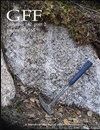A Miocene tetraconodontine (Suidae, Mammalia) from Falkenberg (Halland, Sweden)
IF 1.2
4区 地球科学
Q2 GEOLOGY
引用次数: 1
Abstract
ABSTRACT An isolated suid molar from Falkenberg in Halland, Sweden, is attributed to the extinct Miocene subfamily Tetraconodontinae based on general tooth morphology. The m3 is high-crowned and possesses a shorter talonid than other European tetraconodontines, judging from those species where the m3 is known. The most unusual feature is the highly lifted hypoconulid. Due to these specific dental features, it is not possible to assign the tooth to any known tetraconodontine species, but the material is also insufficient to create a new species. Based on the tooth dimensions, the Falkenberg suid was of the size of a peccary. The biostratigraphic range of Tetraconodontinae in Europe is 15–10 Ma, which implies an Early to Late Miocene age for the tooth. As no Miocene deposits are found in Sweden, the specimen was probably transported from the nearest source area in Southern Jutland, Denmark, by ice rafting. The Falkenberg tooth represents one of the northernmost records of European Miocene land mammals.瑞典Halland Falkenberg发现的一种中新世四齿兽(哺乳动物,蛙科)
来自瑞典Halland Falkenberg的一颗分离的suid磨牙,根据一般的牙齿形态,被归属于已灭绝的中新世Tetraconodontinae亚科。从那些已知m3的物种来看,m3是高冠的,比其他欧洲四齿齿目动物的爪骨更短。最不寻常的特征是高度抬起的下圆锥。由于这些特殊的牙齿特征,不可能将牙齿分配给任何已知的四齿龙物种,但材料也不足以创造一个新的物种。根据牙齿的尺寸,法尔肯伯格猪的大小相当于一颗胸齿。欧洲Tetraconodontinae的生物地层范围为15 ~ 10 Ma,表明该齿的年龄在中新世早期至晚中新世。由于在瑞典没有发现中新世的沉积物,这个标本很可能是从最近的丹麦日德兰半岛南部地区用漂流的方式运来的。Falkenberg牙齿代表了欧洲中新世陆地哺乳动物最北端的记录之一。
本文章由计算机程序翻译,如有差异,请以英文原文为准。
求助全文
约1分钟内获得全文
求助全文
来源期刊

Gff
地学-地质学
CiteScore
2.80
自引率
10.00%
发文量
11
审稿时长
>12 weeks
期刊介绍:
GFF is the journal of the Geological Society of Sweden. It is an international scientific journal that publishes papers in English covering the whole field of geology and palaeontology, i.e. petrology, mineralogy, stratigraphy, systematic palaeontology, palaeogeography, historical geology and Quaternary geology. Systematic descriptions of fossils, minerals and rocks are an important part of GFF''s publishing record. Papers on regional or local geology should deal with Balto-Scandian or Northern European geology, or with geologically related areas. Papers on geophysics, geochemistry, biogeochemistry, climatology and hydrology should have a geological context. Descriptions of new methods (analytical, instrumental or numerical), should be relevant to the broad scope of the journal. Review articles are welcome, and may be solicited occasionally. Thematic issues are also possible.
 求助内容:
求助内容: 应助结果提醒方式:
应助结果提醒方式:


